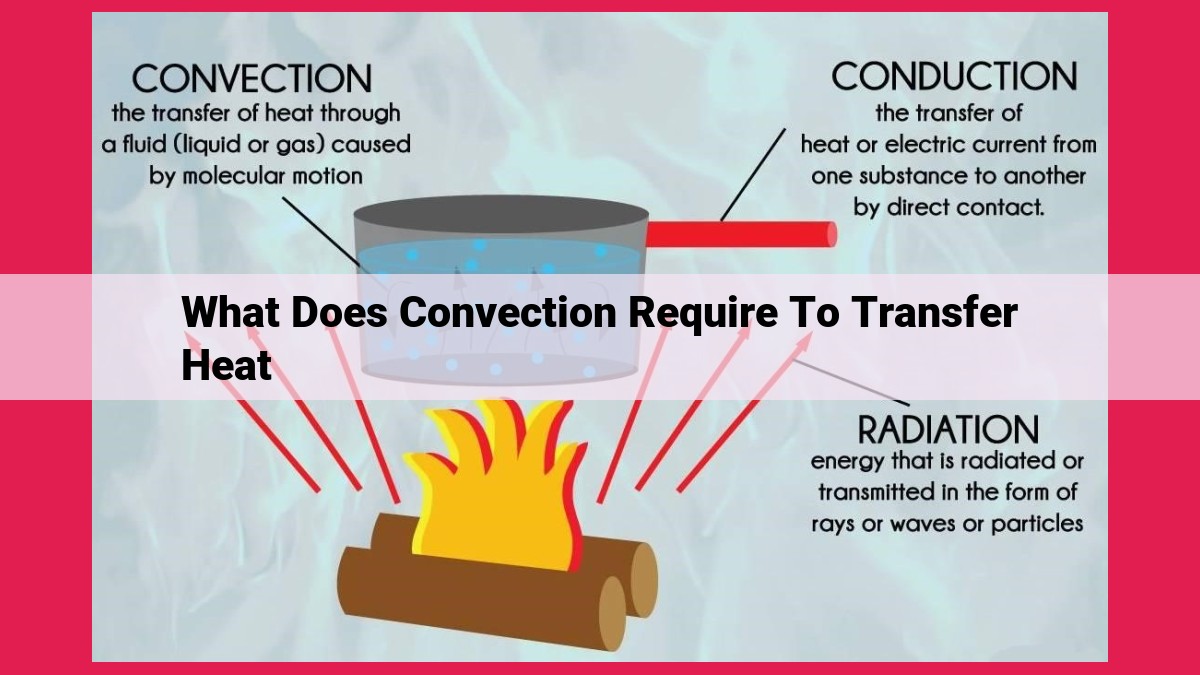Convection Heat Transfer: A Guide To The Essential Elements For Efficient Heat Exchange

Convection heat transfer requires three essential elements: fluids (liquids or gases) as heat carriers, a temperature gradient that drives heat flow, and fluid movement caused by buoyancy forces or external forces. These elements work together to transfer heat from a warmer surface to a cooler one. Fluids move in response to temperature gradients, carrying heat away from hotter regions and transferring it to cooler ones. The properties of the fluids, such as viscosity and density, and the flow rate of the fluid, influence the effectiveness of convection heat transfer.
Convection Heat Transfer: The Essence of Fluid-Driven Heat Transfer
Prepare to voyage into the captivating realm of convection heat transfer, a phenomenon where heat dances through fluids like an invisible waltz. Convection is the transfer of heat through the movement of fluids, either liquids or gases. It is a ubiquitous force in our world, shaping everything from the Earth’s climate to the way we cool our homes.
The key players in convection are fluids, the liquid or gaseous messengers that carry heat from one place to another. Their properties, such as viscosity and density, influence how efficiently they can transport heat. Think of honey versus water: honey’s thicker consistency makes it a less enthusiastic heat carrier than water.
But fluids alone cannot spark the dance of convection. There must also be a temperature gradient, a difference in temperature between two regions. This gradient creates a driving force, prompting the fluid to move from the warmer to the cooler region, carrying heat along its journey.
Essential Elements for Convection Heat Transfer
Fluid Considerations:
Fluids play a crucial role in convection heat transfer. Viscosity, a fluid’s resistance to flow, and density, its mass per unit volume, significantly impact convection. Higher viscosity inhibits fluid movement, while higher density increases buoyancy forces. Liquids and gases serve as the heat-transferring mediums in convection, with each possessing distinct properties that influence heat transfer efficiency.
Temperature Gradient:
Temperature gradient is the driving force behind convection. It is the difference in temperature between two points, which creates a movement of heat from the hotter to the colder region. The thermal conductivity of the fluid, its ability to conduct heat, and boundary layers, thin layers of fluid near solid surfaces that impede heat transfer, are important factors governing the temperature gradient and, thus, convection.
The Role of Fluid Movement in Convection Heat Transfer
Convection heat transfer, where heat is carried by the movement of fluids, plays a crucial role in diverse industries and technologies. In this essential process, fluids like liquids or gases serve as the heat-transferring medium.
Causes of Fluid Movement
Fluid movement is driven by either buoyancy forces or external forces. Buoyancy forces arise when a fluid’s density varies with temperature. For instance, in a heated liquid, the less dense warmer liquid rises above the cooler, denser liquid. External forces, such as pumps or fans, can also induce fluid flow.
Furthermore, fluid velocity, acceleration, and pressure influence its movement. Higher fluid velocity enhances heat transfer efficiency by increasing the heat-carrying capacity of the fluid. Acceleration, caused by changes in velocity, creates pressure differences that drive fluid flow.
Flow Patterns and Heat Transfer
As fluids move, they establish distinctive flow patterns that impact heat transfer. These flow patterns are categorized as laminar or turbulent. Laminar flow occurs when fluid flows smoothly in parallel layers, while turbulent flow is characterized by chaotic and irregular motion.
Turbulent flow enhances heat transfer significantly compared to laminar flow. It promotes greater mixing and randomization of fluid particles, resulting in more effective heat exchange between the fluid and the surrounding surfaces.
Interconnectedness of Convection Principles
Convection heat transfer is a complex phenomenon that requires the interplay of fluid properties, temperature gradient, and fluid movement. The presence of all three elements is essential for effective heat transfer.
In real-world applications, such as cooling systems and heat exchangers, understanding the role of fluid movement is crucial for optimizing heat transfer performance. By manipulating fluid velocity, flow patterns, and external forces, engineers can enhance heat transfer efficiency and meet specific application requirements.
The Interconnected Web of Convection Heat Transfer
Convection heat transfer, a fundamental principle in thermal engineering, involves the intricate interplay of fluid properties, temperature gradients, and fluid movement.
Imagine a pot of water boiling on the stove. As the temperature at the bottom of the pot rises, temperature gradient is established. This gradient drives the water molecules to move, seeking a more balanced thermal state.
The movement of water molecules is influenced by their _fluid properties, such as viscosity and density. Viscosity resists flow, while density determines how easily the fluid can be displaced.
The combination of _temperature gradient_ *and _fluid properties_ *gives rise to convection currents. Buoyancy forces lift the heated water upward, creating a circulating pattern. This fluid movement, in turn, facilitates heat transfer throughout the fluid.
The interconnectedness of these elements is crucial for effective convection. Without a temperature gradient, there’s no driving force for fluid movement. Without fluid movement, heat transfer is limited by conduction. _And without appropriate fluid properties, the movement and heat transfer process can be hindered.
In real-world applications, convection plays a pivotal role. Air conditioning systems use convection currents to circulate cool air, while _radiators_ *rely on convection to dissipate heat from engines. Kitchen ventilation hoods *remove cooking fumes and odors by harnessing the convective flow of air.
The interconnectedness of convection principles is a testament to the power of science. By understanding the interplay of these elements, engineers and designers can optimize systems for efficient heat transfer and a comfortable thermal environment.